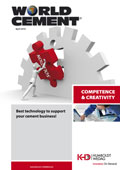Editorial comment
For anyone interested in statistical data for the cement industry, the World Statistical Data Review from CEMBUREAU is a definite must-have. Covering 1996 – 2008, the Review tracks worldwide cement consumption, production, per capita consumption, population, etc. It is interesting to see how production and consumption patterns changed over the 12 years under discussion – with dramatic growth in some countries and far more gradual inclines in others. Statistics are listed by continent, by region and by country, which, when examined, shows the intra-national/regional/continental diversity in development that could be easily forgotten.
Register for free »
Get started now for absolutely FREE, no credit card required.
Of course, development is dependent on resources and, for the cement industry, this means both geological and financial resources. The statistics presented in the Review reaffirm the cement industry’s position as an economic indicator – countries require natural resources to flourish. On top of that, ideally those resources should be spread out throughout the country, or else infrastructure needs to be sufficiently developed to make sure that all parts of the country are able to make use of them. In Vietnam, for example, which is the focus of this month’s Regional Report, there is a geographical imbalance in the cement industry from north to south. Articles in this issue highlight the challenges the industry faces when evening out the balance of supply and demand across the country, as well as in the wider world, as an oversupply situation looms here and elsewhere, creating greater competition amongst exporting countries whilst simultaneously diminishing the import market. Paul Maxwell-Cook concentrated his March Regional Insight on this Asian ‘tiger cub,’ and its relationship with China in light of its decision to join the China-ASEAN Free Trade Area (CAFTA) by 2015. This Regional Insight is still available for subscribers to download at worldcement.com, and on 1 April the latest one – looking at how Brazil was one of the first emerging markets to begin recovering from the global financial crisis – will also be available.
Aside from the Regional Insight and a digital edition of the magazine available to download up to two weeks before the hard copy lands on your desk, subscribers also benefit from the knowledge that they will never miss an issue of World Cement. Obviously, every issue of WORLD CEMENT is heaving with technical, economical and regional information, but the May issue will be particularly special; it is our Environmental Issue – part of our new series of Special Issues – and it includes articles on blended cements, environmental upgrades, quarry rehabilitation, filtration, mercury monitoring, alternative fuels, and more. We will have insights from Holcim, Cemex, Heidelberg and CEMBUREAU on the topic of reducing CO2, as well as thoughts from some leading minds on what the NESHAP will mean for the US cement industry. This editorial comment isn’t usually a place for shameless self-promotion, but I am so excited by what the next issue will offer that I wanted to make sure no one misses out. Subscribing to World Cement is easy – simply fax back the form on page 38 or visit worldcement.com. Alternatively, for the personal touch and to find out what discounts are available on multiple subscriptions, email laura.cowell@worldcement.com and Laura will be happy to help. In the meantime, enjoy this packed conference issue, which includes a preview of the 22nd ASEAN Federation of Cement Manufacturers Technical Symposium and profiles from some of the companies exhibiting at bauma 2010. World Cement will be attending both events, so be sure to drop by and say hello.


